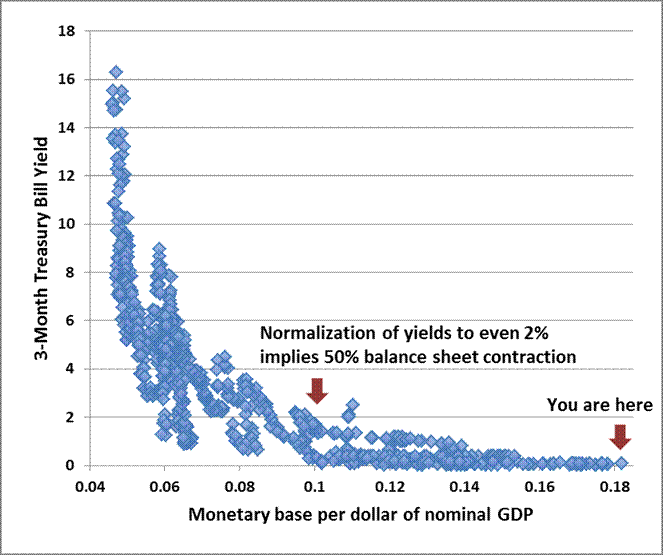Government intervention in the U.S. economy is approaching the point where probable long-term costs exceed short-term benefits – straining to maintain the pace of extraordinary fiscal and monetary measures that have repeatedly nudged the U.S. economy from the border between new recession and tepid growth for three years. U.S. Treasury debt now exceeds 105% of GDP (publicly held debt approaching 75% of GDP). Meanwhile, the Federal Reserve has expanded the monetary base to more than 18% of GDP (18 cents per dollar of nominal GDP), where a century of U.S. economic history indicates that a normalization to Treasury bill yields of just 2% could not tolerate more than 9 cents of monetary base per dollar of GDP without inflation. The federal government continues to run a deficit of about 7% of GDP, which the $85 billion sequester would reduce to about 6.5% under the unlikely assumption that economic activity and revenues don’t contract somewhat. Current Federal Reserve policy absorbs about $45 billion per month in new government debt as part of QEternity, but even the Fed continues this policy indefinitely, U.S. publicly held debt is still likely to expand by several percent annually assuming no recession occurs. Any eventual normalization of Fed policy would dump Treasuries back into public hands (or require public purchases of new debt in the event the Fed decides to let the holdings “roll off” as they mature). Massive policy responses, directed toward ineffective ends, are scarcely better than no policy response at all.
Let’s take a look at the current monetary and fiscal policy environment, and then examine more effective policy initiatives and why they make sense.
Monetary Policy – All In
To offer a visual picture of where monetary policy stands at present, the chart below depicts the current situation, as well as data points since 1929. As of last week, the U.S. monetary base stands at a record 18 cents per dollar of nominal GDP. The last time the monetary base reached even 17 cents per dollar of nominal GDP was in the early 1940’s. The Fed did not reverse this with subsequent restraint. Instead, consumer prices nearly doubled by 1952. At present, a normalization of short-term interest rates to even 2% could not be achieved without cutting the Fed’s balance sheet by more than half. Alternatively, the Fed could wait for nominal GDP to double and “catch up” to the present level of base money, which would take about 14 years, assuming 5% nominal GDP growth.
Of course, 5% nominal growth would likely make it inappropriate to hold short-term interest rates below 2% for another 14 years. So either the Fed will reverse its present course, or we will experience unacceptable inflation, or we will experience persistently weak growth like Japan has experienced since 1999, when it decided to take Bernanke’s advice to pursue quantitative easing. My guess is that we will experience unacceptable inflation, beginning in the back-half of this decade.

Because of the strong relationship between the size of the monetary base (per dollar of nominal GDP) and short-term interest rates, it appears likely that short-term interest rates will be suppressed by Fed policy for some time, until Fed policy normalizes or inflation accelerates. The Fed is now leveraged 55-to-1 against its own capital. With an estimated duration of about 8 years on $3 trillion of bond holdings, every 100 basis point move in long-term interest rates can be expected to alter the value of the Fed’s holdings by about $240 billion – roughly four times the amount of capital reported on the Fed’s consolidated balance sheet.
Read the complete commentary
Let’s take a look at the current monetary and fiscal policy environment, and then examine more effective policy initiatives and why they make sense.
Monetary Policy – All In
To offer a visual picture of where monetary policy stands at present, the chart below depicts the current situation, as well as data points since 1929. As of last week, the U.S. monetary base stands at a record 18 cents per dollar of nominal GDP. The last time the monetary base reached even 17 cents per dollar of nominal GDP was in the early 1940’s. The Fed did not reverse this with subsequent restraint. Instead, consumer prices nearly doubled by 1952. At present, a normalization of short-term interest rates to even 2% could not be achieved without cutting the Fed’s balance sheet by more than half. Alternatively, the Fed could wait for nominal GDP to double and “catch up” to the present level of base money, which would take about 14 years, assuming 5% nominal GDP growth.
Of course, 5% nominal growth would likely make it inappropriate to hold short-term interest rates below 2% for another 14 years. So either the Fed will reverse its present course, or we will experience unacceptable inflation, or we will experience persistently weak growth like Japan has experienced since 1999, when it decided to take Bernanke’s advice to pursue quantitative easing. My guess is that we will experience unacceptable inflation, beginning in the back-half of this decade.

Because of the strong relationship between the size of the monetary base (per dollar of nominal GDP) and short-term interest rates, it appears likely that short-term interest rates will be suppressed by Fed policy for some time, until Fed policy normalizes or inflation accelerates. The Fed is now leveraged 55-to-1 against its own capital. With an estimated duration of about 8 years on $3 trillion of bond holdings, every 100 basis point move in long-term interest rates can be expected to alter the value of the Fed’s holdings by about $240 billion – roughly four times the amount of capital reported on the Fed’s consolidated balance sheet.
Read the complete commentary
